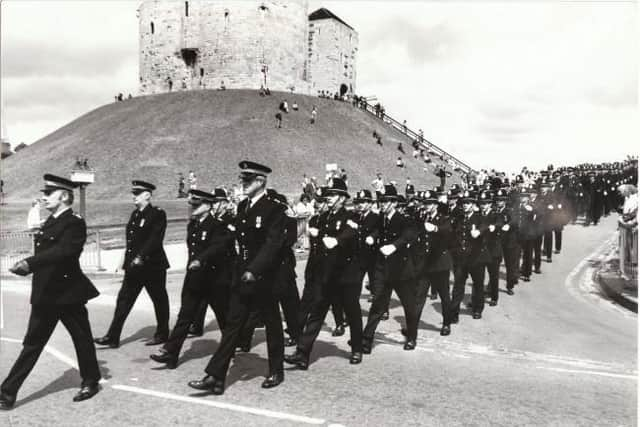How four new police forces were formed during local government reorganisation 50 years ago
Constabulary boundaries were redrawn, and four new police services were formed.
Among them was North Yorkshire Police force, formed to cover an area previously looked after by predecessors,including the North Riding Constabulary, City of York Police and the short-lived York and North East Yorkshire Police.
Advertisement
Hide AdAdvertisement
Hide AdIt also brought in adopted parts of neighbouring police forces such as Craven, which used to fall under West Yorkshire.


Reflecting on policing in the 1970s, a spokesperson for North Yorkshire Police said: “The military pomp and rank formalities of 1950s policing had softened slightly.
“But being ordered to the Inspector’s office could still strike fear into the heart of even a seasoned constable.
“We evolved into a more ‘tactical’ organisation, to keep up with changing demand. Task forces, tactical units and specialised skills training for our officers became more common.”
Advertisement
Hide AdAdvertisement
Hide AdJust months after the force’s formation in 1974, officers were tasked with a mammoth manhunt for the murderer of Donald Skepper, a Harrogate sub-postmaster. Police caught Donald Neilson, who the press called the ‘Black Panther’, and he was later jailed for life for crimes including Mr Skepper’s murder and the murder and kidnap of heiress Lesley Whittle.
Officers also had to deal with one of the worst road accidents in British history the following year, when a bus carrying 45 women in the Yorkshire Dales crashed through Dibbles Bridge.
Some 33 were killed, including the driver, with the remaining passengers seriously injured.
North Yorkshire Police’s Chief Officer Team said: “North Yorkshire Police still reflects many of the values it always held dear. Our officers take pride in serving their community, getting to know people and being part of the fabric of North Yorkshire, which we know is still very important to people who live and work in our county.
Advertisement
Hide AdAdvertisement
Hide Ad“But policing is also about adapting to change, whether that’s in our culture and ideologies or our operational response to criminality. Our technology, the development of specialist teams and our wider focus on not just catching criminals but also supporting victims, are just a few of the changes that were impossible to envisage when the force was formed in 1974.”
*****
A police officer who has served South Yorkshire Police (SYP) for half a century has shared his memories as the Force marks its 50th anniversary.
Special Constable Paul Brown, 69, from near Doncaster, joined Sheffield and Rotherham Constabulary as a cadet aged just 19.
He began serving as a mounted officer in 1981, going on to serve on the mounted unit at the London 2012 Olympics, and received a British Empire Medal in 2015.
Advertisement
Hide AdAdvertisement
Hide AdHe came back to SYP a day after his formal retirement in 2015 - this time as a special constable - and is believed to be the force’s longest serving officer.
Recollecting the day South Yorkshire Police was formed, Special Constable Brown said: “On April 1, we had a bit of a ceremony to change our helmet plates to South Yorkshire Police.
“It did take quite a bit of time to gel how everybody operated. It was old school - there were not enough radios to go around.
“The biggest change I’ve seen is in technology, although I’ve been on the mounted unit for 43 years, and not a lot changes for the horses!
Advertisement
Hide AdAdvertisement
Hide Ad“There was no national computer. Now we carry phones which can identify fingerprints and vehicle registrations in seconds.”
Mr Brown, a father-of-three and grandfather-of-three, reflected on how policing had changed. “It was the era of Dixon of Dock Green,” he said.
“You’d go out on patrol on your own. There are more violent crimes now. 50 years ago, the officers knew people on the beat and the area, now they’re all over the place.
“You had your ‘tea spots’ where you’d get your information from local businesses and residents.”
Advertisement
Hide AdAdvertisement
Hide AdWhile Mr Brown’s police work has included two of the major events in South Yorkshire’s recent history, the 1989 Hillsborough tragedy and the miners’ strike, it was the solving of a much more simple crime in 1975 that has particularly stayed with him.
“It was the theft of a precious cigarette lighter in a pub,” he said. “It had been stolen during a game of cards. After I found it, I stayed in touch with the family, and when the man passed away, his wife contacted me and presented me with the lighter.”
Comment Guidelines
National World encourages reader discussion on our stories. User feedback, insights and back-and-forth exchanges add a rich layer of context to reporting. Please review our Community Guidelines before commenting.